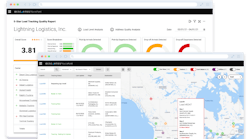If you’re looking for an example of a government agency that performs regular inspections of the workplace, look no further than the Mine Safety and Health Administration, or MSHA. MSHA governs all of the mines in the U.S.—from the local gravel quarry to the mammoth open pit and underground mining operations. When it comes to maintaining or repairing the equipment that operates in these environments, MSHA inspectors always make sure the “lock out, tag out” rule is regularly followed to prevent an accident.
The trucking industry could learn a valuable lesson from their brothers in mining. In the past two years, a total of six people have been fatally injured in the types of accidents that lock out, tag out is designed to prevent. According to the Occupational Safety and Health Administration (OSHA), here is how each of them died: - Worker performing maintenance on a tow truck was killed when he was hit and dragged by the moving truck.
- Worker checking the rear brakes on his truck died after the truck ran over him.
-Worker checking an air leak underneath a truck was killed when the vehicle ran over him, dragging him 80 ft.
- Worker servicing a truck’s brakes was killed after the truck moved in reverse and struck, dragged, and ran over her.
-Worker changing a tire was struck and killed by a trailer.
- Worker adjusting the brakes underneath a tractor-trailer was crushed when the truck rolled forward.
Most of those accidents occurred at trucking companies, so it’s time for the industry to step up and recognize that there may be a problem. And with all of the emphasis on brake and tire inspection under CSA, the number of people crawling underneath tractors and trailers is only going to increase. Rather than wait for the issue to escalate or hit home, I think every fleet should implement and communicate a lock out, tag out procedure when equipment is being worked on or inspected.
It’s unfair to speculate on the details regarding those six accidents, but it’s also reasonable to think that at least a couple of them were preventable. For example, if the correct wheel chocks are in place whenever a vehicle is being inspected, maintained or serviced, it’s unlikely that any sudden or unexpected movement will put an employee at risk while they are under the vehicle. It’s an extra step and an extra expense, but the consequences are pretty clear if something goes wrong. Likewise, drivers are reluctant to give up their keys, but that is the only way that a technician can guarantee that someone doesn’t jump in the cab and drive off while they are servicing the tires and brakes. It happened to me when I was a young technician, and I can tell you from first-hand experience that it scares the life out of you.
Establishing a lock out, tag out procedure is only the start. It needs to be communicated to each employee so anyone who comes in contact with the equipment follows the steps and is aware of the signs that indicate a vehicle is not to be moved. And whenever there is a chance that someone could be underneath the vehicle for any reason or length of time, there should be a system in place to prevent unforeseen movement and warn everyone that work is being performed. Finally, outside vendors who perform service on trucking company property must be held to the same standard.
So the message to everyone is lock out, tag out, or get out (and don’t come back).


